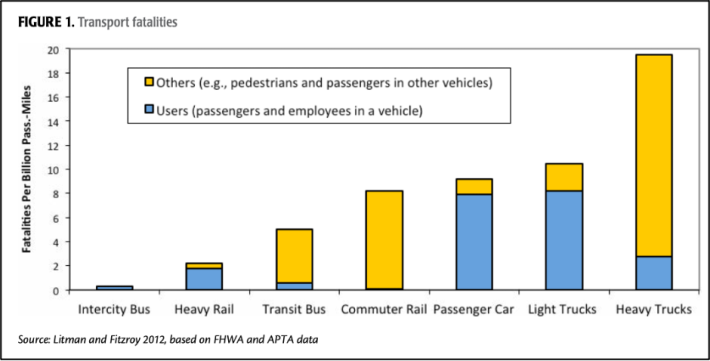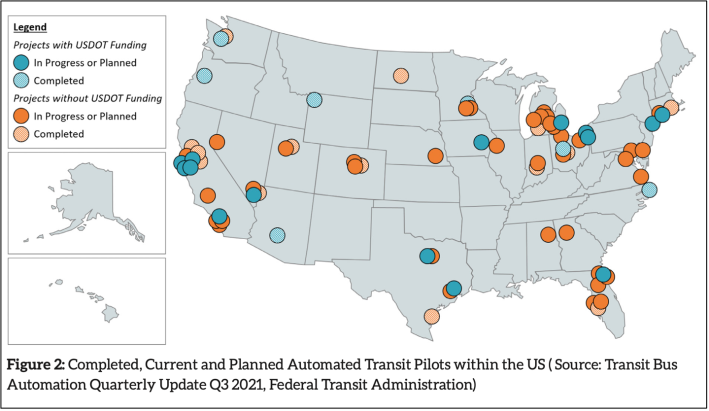Automated vehicle technology could improve labor conditions for bus drivers rather than forcing them out of a job, while simultaneously improving safety and service for transit passengers and city-dwellers alike — but only if regulators act now, a new analysis argues.
From the time the first semi-automated train first took to the rails way back in 1967 to the pilot programs that are sending semi-automated buses onto global roads today, transit advocates have envisioned a future where advanced technology would be installed behind the wheel of every shared transportation vehicle.
Not everyone has the welcomed that future, though. Chief among those concerns is that bus drivers — a critical and already chronically undervalued and underpaid segment of the U.S. workforce — would eventually be forced out of their jobs, particularly as buses require less and less human supervision behind the wheel.
According to a team of Carnegie Mellon researchers, though, the rise in vehicle automation technology — at least in the imperfect form in which it's expected to exist for the next few decades — may actually make trained transit professionals more important than ever before, and possibly even elevate their societal status and pay to a level similar to commercial airline pilots as the two jobs become more and more similar. But that will only happen if federal regulators take action now before the next wave of robo-transit is rolled out around the world, and keep public and operator safety at front of mind.
"A lot of people think an 'autonomous bus' means that there’s no driver behind the wheel, but I personally believe that’s quite far away," said Nikolas Martelaro, an assistant professor of human-computer interaction at Carnegie Mellon University and a co-author of the study. "But in the meantime, advanced driver assistance systems are already being designed into buses today, and that tech could be more widely available soon. Those systems need to be studied closely — and we really need to talk about how labor will interact with them."
Europe’s first self-driving bus! #SelfDrivingCars #AI
— Olivier Laborde #VivaTech2023🇫🇷🇪🇺🇺🇦 (@labordeolivier) May 17, 2022
v/@iamBrianGraham@sebbourguignon @enilev @Khulood_Almani @AshokNellikar @baski_LA @CurieuxExplorer @JeroenBartelse @FrRonconi @NevilleGaunt @MargaretSiegien @PawlowskiMario @mvollmer1 @AlbertoEMachadohttps://t.co/QRY2Sqoe19
Making a safe mode even safer
Just like automated private vehicles, one of the foremost ambitions of the automated transit movement is ending traffic violence — though Martelaro is quick to note that buses are already the single safest mode of transportation on the road.
Studies have long shown that bus passengers are 60 times safer than car passengers on the road, thanks in no small part to the skill of human transit drivers. And that's generally true for people outside busses, too: studies have found that just 2 percent of U.S. pedestrian fatalities involve buses at all, compared to the more than 95 percent that involve cars or trucks, and that cities on the whole get safer for walkers the more people ride transit rather than drive.
On the rare occasion that a bus driver does strike a pedestrian, though, those crashes are disproportionately likely to be fatal, for pretty much the same reason that SUVs and pickup crashes are so deadly: because they're huge, heavy, and designed with tall, blunt front ends that are all but certain to hit a walker at the level of the head, neck, and vital organs.

Add in the massive blind spots inherent to massive vehicles (at least when they aren't designed to Direct Vision standards to enhance visibility), and the Amalgamated Transit Union itself estimates that every single week, one U.S. pedestrian is killed by a bus driver who simply couldn't see the person right in front of them — a problem that industry professionals themselves hope technology might help solve.
"We are calling on our industry to bring the best technology to our buses and trains, starting with the driver’s workstation," wrote Larry Hanley, then the international president of the ATU back in 2017. "If we can get North America to adopt the advanced European motor coach workstation we will...reduce pedestrian fatalities."
When bus drivers become pilots
Reducing bus-pedestrian crashes, though, isn't quite the same thing as ending them outright. And just like with private AVs, achieving Vision Zero will be particularly hard in the unpredictable urban environments where buses operate it most — which also happen to be the environments automated vehicles are least skilled at navigating.
Martelaro and his colleagues stress that US DOT, the Federal Motor Vehicle Carrier Safety Administration, and the Federal Transit Administration must work holistically to make sure that that automated buses and their operators are fully road-ready before they roll into U.S. neighborhoods, and that the industry is held to the highest standards of the safety for passengers, passerby, and transit pros themselves. Part of that equation might involve making sure roads are ready for automated buses, by designating rapid transit lanes or even whole streets specifically for the emerging mode.
And it should certainly involve the strictest possible off-road testing requirements, rather than irresponsible approach currently in use among some members of the private AV industry.
"When Tesla’s testing this technology on public roads with untrained drivers — well, let’s just say I don’t know if that’s the most appropriate way to do things," he added. "And when we do those tests, that data should be shared among municipalities, and at the level of the US DOT. We have plenty of examples of that approach in aviation, where it's normal for companies to share information and make sure there's safe service."

As bus drivers become more like airplane pilots supervising a highly automated (but not 100 percent autonomous) control station, Martelaro stresses that operators will be subjected to unique new stresses — and counterintuitively, that could make driving a semi-automated bus harder, even as vehicles themselves do more of the traditional work of navigating city streets. Like federal aviation authorities and airlines before them, the transit industry will have to find ways to keep drivers alert and ready to take over when imperfect automated systems fail, as well as ways to keep their driving skills sharp even on days when they rarely need to touch the wheel.
Because when drivers do need to intervene, it will be in the deadliest of all possible scenarios.
"Automated systems tend to do fine in the easiest situations, and then hand control back to the operator in the most challenging situations," adds Martelaro. "A pilot can put the plane into autopilot, but when there’s a serious problem like a bird strike — think Sully Sullenberger — they have to take over in a super stressful moment, and do it very quickly. These sorts of exceptional things are going to happen to bus drivers, and they need to be really well prepared for that."
More than a driver
In some ways, of course, today's bus drivers already have a far more complex job than airline pilots — and not just because they travel through populous neighborhoods rather than open skies.
Unlike a captain confined to a cockpit, many transit operators double as critical first responders to a dizzying array other tasks, for which they're mostly not compensated or given many resources. In addition to driving, they're often responsible for providing basic vehicle maintenance, supervising fare collection, giving directions to passengers, helping passenger with mobility challenges get on and off the bus, and even intervening when there's violence, harassment, or disturbances onboard their vehicles.
Martelaro isn't sure whether automation will free drivers up to perform those non-driving tasks more effectively, or whether it will finally make the case for an even larger transit workforce, the same way airline pilots are assisted by flight attendants. (And it could also spark a conversation about the differences in pay and benefits between the two industries; the median annual earnings of bus drivers are currently just 36 percent of commercial pilots' salaries, even though no captain is ever asked to juggle supervising an autopilot system with helping a sick passenger.)
"Our big conclusion is, as automated systems become more common, there’s definitely going to be a role for a trained operator on board, but that role might be different," he adds. "They may have more time to attend to all the complexity of what's happening on board, [or it might add on] a bunch of new technologies that need monitoring and add to their work load. We should be asking ourselves: how does automation change the nature of all the onboard work drivers do?"
However it shakes out, Martelaro says the transportation industry needs to confront the changing nature of transit work now, before automated vehicle tech is common — and that will probably require a tough reckoning with how under-valued American bus operators have pretty much always been.
"The nature of the job will change," he added. "It may reduce the level of work [bus drivers do] in some ways, but it may also lead to bus drivers being more trained and more responsible in others — and they're already responsible for so much... I’m not an economist, nor do I run a public transit company, but it seems likely, to me, that this work will be elevated."






